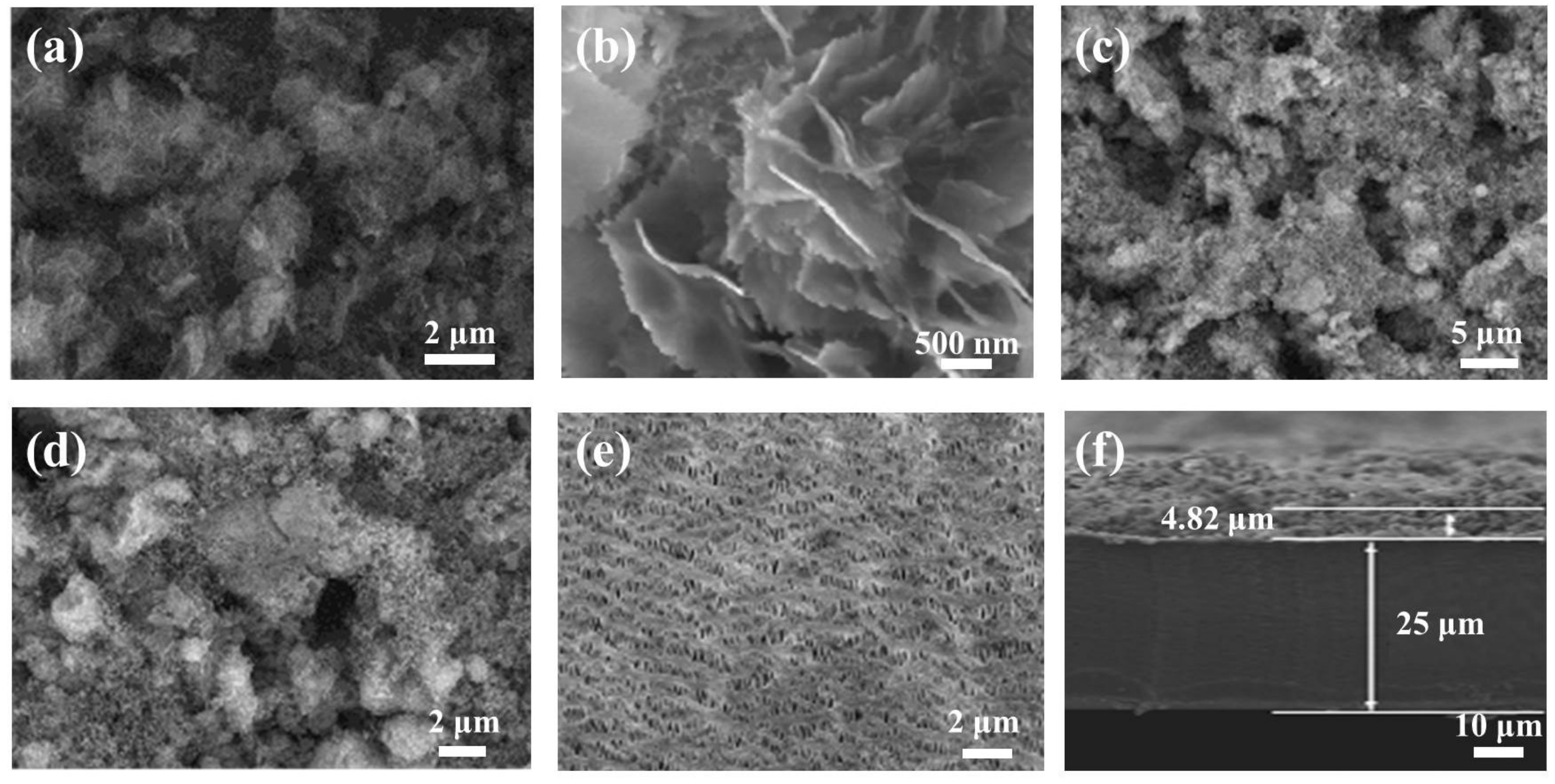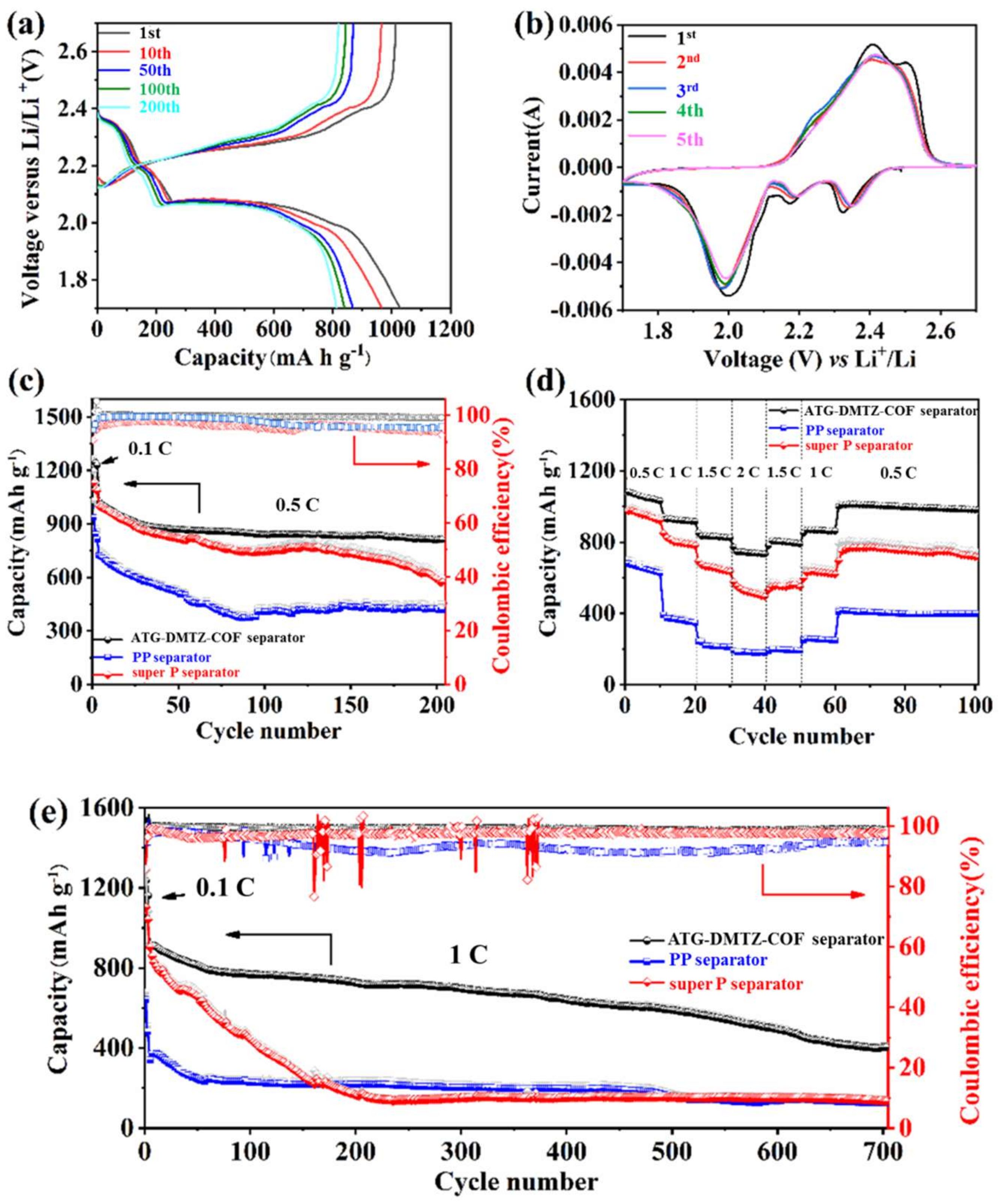Cationic Covalent Organic Framework as Separator Coating for High-Performance Lithium Selenium Disulfide Batteries
Abstract
:1. Introduction
2. Materials and Methods
2.1. Synthesis of ATG-DMTZ-COF
2.2. Preparation of ATG-DMTZ-COF Composite Separator
2.3. Characterization
2.4. Electrochemical Measurements
3. Results
4. Conclusions
Supplementary Materials
Author Contributions
Funding
Institutional Review Board Statement
Informed Consent Statement
Data Availability Statement
Acknowledgments
Conflicts of Interest
References
- Abada, S.; Marlair, G.; Lecocq, A.; Sauvant-Moynot and Huet, F. Safety focused modeling of lithium-ion batteries: A review. J. Power Sources 2016, 306, 178–192. [Google Scholar] [CrossRef]
- Choi, J.W.; Aurbach, D. Promise and reality of post-lithium-ion batteries with high energy densities. Nat. Rev. Mater. 2016, 1, 16013. [Google Scholar] [CrossRef]
- Myung, S.-T.; Maglia, F.; Park, K.-J.; Yoon, C.S.; Lamp, P.; Kim, S.-J.; Sun, Y.-K. Nickel-rich layered cathode materials for automotive lithium-ion batteries: Achievements and perspectives. ACS Energy Lett. 2017, 2, 196–223. [Google Scholar] [CrossRef]
- Xiong, R.; Yu, Q.; Wang, L.Y.; Lin, C. A novel method to obtain the open circuit voltage for the state of charge of lithium ion batteries in electric vehicles by using h infinity filter. Appl. Energy 2017, 207, 346–353. [Google Scholar] [CrossRef]
- Huang, S.-Z.; Cai, Y.; Jin, J.; Liu, J.; Li, Y.; Yu, Y.; Wang, H.E.; Chen, L.H.; Su, B.L. Hierarchical mesoporous urchin-like mn3o4/carbon microspheres with highly enhanced lithium battery performance by in-situ carbonization of new lamellar manganese alkoxide (mn-deg). Nano Energy 2015, 12, 833–844. [Google Scholar] [CrossRef]
- Jin, J.; Tian, X.; Srikanth, N.; Zhou, K. Advances and challenges of nanostructured electrodes for li–se batteries. J. Mater. Chem. A 2017, 5, 10110–10126. [Google Scholar] [CrossRef]
- Bruce, P.G.; Freunberger, S.A.; Hardwick, L.J.; Tarascon, J.-M. Li–O2 and li–s batteries with high energy storage. Nat. Mater. 2012, 11, 19–29. [Google Scholar] [CrossRef]
- Li, X.; Liang, J.; Hou, Z.; Zhang, W.; Wang, Y.; Zhu, Y.; Qian, Y. A new salt-baked approach for confining selenium in metal complex-derived porous carbon with superior lithium storage properties. Adv. Funct. Mater. 2015, 25, 5229–5238. [Google Scholar] [CrossRef]
- Gao, X.-T.; Xie, Y.; Zhu, X.-D.; Sun, K.N.; Xie, X.M.; LIU, Y.T.; Yu, J.Y.; Ding, B. Ultrathin mxene nanosheets decorated with tio2 quantum dots as an efficient sulfur host toward fast and stable li–s batteries. Small 2018, 14, 1802443. [Google Scholar] [CrossRef]
- Lei, D.; Shi, K.; Ye, H.; Wang, Z.; Wang, Y.; Shen, L.; Li, B.; Yang, Q.H.; Kang, F.; He, Y.B. Progress and perspective of solid-state lithium–sulfur batteries. Adv. Funct. Mater. 2018, 28, 1707570. [Google Scholar] [CrossRef]
- Wang, X.; Pan, Z.; Zhuang, J.; Li, G.; Ding, X.; Liu, M.; Zhang, Q.; Liao, Y.; Zhang, Y.; Li, W. Simultaneously regulating lithium ion flux and surface activity for dendrite-free lithium metal anodes. ACS Appl. Mater. Interfaces 2019, 11, 5159–5167. [Google Scholar] [CrossRef]
- Salhabi, E.H.M.; Zhao, J.; Wang, J.; Yang, M.; Wang, B.; Wang, D. Hollow multi-shelled structural tio2−x with multiple spatial confinement for long-life lithium–sulfur batteries. Angew. Chem. 2019, 131, 9176–9180. [Google Scholar] [CrossRef]
- Song, Y.; Zhao, W.; Wei, N.; Zhang, L.; Ding, F.; Liu, Z.; Sun, J. In-situ pecvd-enabled graphene-v2o3 hybrid host for lithium–sulfur batteries. Nano Energy 2018, 53, 432–439. [Google Scholar] [CrossRef]
- Zhao, Y.; Wang, D.; Gao, Y.; Chen, T.; Huang, Q.; Wang, D. Stable li metal anode by a polyvinyl alcohol protection layer via modifying solid-electrolyte interphase layer. Nano Energy 2019, 64, 103893. [Google Scholar] [CrossRef]
- Wang, T.; Zhu, J.; Wei, Z.; Yang, H.; Ma, Z.; Zhou, J.; Yang, Y.; Peng, L.; Fei, H.; Lu, B.; et al. Bacteria-derived biological carbon building robust li–s batteries. Nano Lett. 2019, 19, 4384–4390. [Google Scholar] [CrossRef]
- Xu, Z.-L.; Lin, S.; Onofrio, N.; Zhou, L.; Shi, F.; Lu, W.; Kang, K.; Zhang, Q.; Lau, S.P. Exceptional catalytic effects of black phosphorus quantum dots in shuttling-free lithium sulfur batteries. Nat. Commun. 2018, 9, 4164. [Google Scholar] [CrossRef]
- Lim, J.; Pyun, J.; Char, K. Recent approaches for the direct use of elemental sulfur in the synthesis and processing of advanced materials. Angew. Chem. Int. Ed. 2015, 54, 3249–3258. [Google Scholar] [CrossRef]
- Pang, Q.; Liang, X.; Kwok, C.Y.; Nazar, L.F. Advances in lithium–sulfur batteries based on multifunctional cathodes and electrolytes. Nat. Energy 2016, 1, 16132. [Google Scholar] [CrossRef]
- Seh, Z.W.; Sun, Y.; Zhang, Q.; Cui, Y. Designing high-energy lithium–sulfur batteries. Chem. Soc. Rev. 2016, 45, 5605–5634. [Google Scholar] [CrossRef]
- Gu, X.; Lai, C. One dimensional nanostructures contribute better li–s and li–se batteries: Progress, challenges and perspectives. Energy Storage Mater. 2019, 23, 190–224. [Google Scholar] [CrossRef]
- Lim, W.-G.; Kim, S.; Jo, C.; Lee, J. A comprehensive review of materials with catalytic effects in li–s batteries: Enhanced redox kinetics. Angew. Chem. Int. Ed. 2019, 58, 18746–18757. [Google Scholar] [CrossRef] [PubMed]
- Yang, C.-P.; Yin, Y.-X.; Guo, Y.-G. Elemental selenium for electrochemical energy storage. J. Phys. Chem. Lett. 2015, 6, 256–266. [Google Scholar] [CrossRef] [PubMed]
- Abouimrane, A.; Dambournet, D.; Chapman, K.W.; Chupas, P.J.; Weng, W.; Amine, K. A new class of lithium and sodium rechargeable batteries based on selenium and selenium–sulfur as a positive electrode. J. Am. Chem. Soc. 2012, 134, 4505–4508. [Google Scholar] [CrossRef] [PubMed]
- Cui, Y.; Abouimrane, A.; Lu, J.; Bolin, T.; Ren, Y.; Weng, W.; Sun, C.; Maroni, V.A.; Heald, S.M.; Amine, K. (De)lithiation mechanism of li/sesx (x = 0–7) batteries determined by in situ synchrotron x-ray diffraction and x-ray absorption spectroscopy. J. Am. Chem. Soc. 2013, 135, 8047–8056. [Google Scholar] [CrossRef]
- Zhang, J.; Li, Z.; Lou, X.W. A freestanding selenium disulfide cathode based on cobalt disulfide-decorated multichannel carbon fibers with enhanced lithium storage performance. Angew. Chem. Int. Ed. 2017, 56, 14107–14112. [Google Scholar] [CrossRef]
- Zhang, Z.; Jiang, S.; Lai, Y.; Li, J.; Song, J.; Jie, L. Selenium sulfide@mesoporous carbon aerogel composite for rechargeable lithium batteries with good electrochemical performance. J. Power Sources 2015, 284, 95–102. [Google Scholar] [CrossRef]
- Li, Z.; Zhang, J.; Wu, H.B.; Lou, X.W. An improved li–ses2 battery with high energy density and long cycle life. Adv. Energy Mater. 2017, 7, 1700281. [Google Scholar] [CrossRef]
- Dong, P.; Zhang, X.; Cha, Y.; Lee, J.I.; Song, M.K. In situ surface protection of lithium metal anode in lithium–selenium disulfide batteries with ionic liquid-based electrolytes. Nano Energy 2020, 69, 104434. [Google Scholar] [CrossRef]
- Zhang, H.; Zhou, L.; Huang, X.; Song, H.; Yu, C. Encapsulation of selenium sulfide in double-layered hollow carbon spheres as advanced electrode material for lithium storage. Nano Res. 2016, 9, 3725–3734. [Google Scholar] [CrossRef]
- Chen, T.; Kong, W.; Fan, M.; Zhang, Z.; Wang, L.; Chen, R.; Hu, Y.; Ma, J.; Jin, Z. Chelation-assisted formation of multi-yolk–shell co4n@carbon nanoboxes for self-discharge-suppressed high-performance li–ses2 batteries. J. Mater. Chem. A 2019, 7, 20302–20309. [Google Scholar] [CrossRef]
- He, J.; Lv, W.; Chen, Y.; Xiong, J.; Wen, K.; Xu, C.; Zhang, W.; Li, Y.; Qin, W.; He, W. Direct impregnation of ses2 into a mof-derived 3d nanoporous co–n–c architecture towards superior rechargeable lithium batteries. J. Mater. Chem. A 2018, 6, 10466–10473. [Google Scholar] [CrossRef]
- Liu, C.; Huang, X.; Wang, J.; Song, H.; Yang, Y.; Liu, Y.; Li, J.; Wang, L.; Yu, C. Hollow mesoporous carbon nanocubes: Rigid-interface-induced outward contraction of metal-organic frameworks. Adv. Funct. Mater. 2018, 28, 1705253. [Google Scholar] [CrossRef]
- Guo, B.; Yang, T.; Du, W.; Ma, Q.; Zhang, L.-z.; Bao, S.-J.; Li, X.; Chen, Y.; Xu, M. Double-walled n-doped carbon@nico2s4 hollow capsules as ses2 hosts for advanced li–ses2 batteries. J. Mater. Chem. A 2019, 7, 12276–12282. [Google Scholar] [CrossRef]
- Li, Z.; Zhang, J.; Guan, B.Y.; Lou, X.W. Mesoporous carbon@titanium nitride hollow spheres as an efficient ses2 host for advanced li–ses2 batteries. Angew. Chem. Int. Ed. 2017, 56, 16003–16007. [Google Scholar] [CrossRef]
- Wang, M.; Guo, Y.; Wang, B.; Luo, H.; Zhang, X.; Wang, Q.; Zhang, Y.; Wu, H.; Liu, H.; Dou, S. An engineered self-supported electrocatalytic cathode and dendrite-free composite anode based on 3d double-carbon hosts for advanced li–ses2 batteries. J. Mater. Chem. A 2020, 8, 2969–2983. [Google Scholar] [CrossRef]
- Kim, J.; Kim, J.H.; Ariga, K. Redox-Active Polymers for Energy Storage Nanoarchitectonics. Joule 2017, 1, 739–768. [Google Scholar] [CrossRef] [Green Version]
- Lee, J.; Choi, S.H.; Qutaish, H.; Hyen, Y.; Han, S.A.; Heo, Y.; Whang, D.; Lee, J.; Moon, J.; Park, M.; et al. Structurally stabilized lithium-metal anode via surface chemistry engineering. Energy Storage Mater. 2021, 37, 315–324. [Google Scholar] [CrossRef]
- Kim, J.; Lee, J.; Yun, J.; Choi, S.H.; Han, S.; Moon, J.; Kim, J.H.; Lee, J.; Park, M. Functionality of Dual-Phase Lithium Storage in a Porous Carbon Host for Lithium-Metal Anode. Adv. Funct. Mater. 2022, 30, 1910538. [Google Scholar] [CrossRef]
- Qutaish, H.; Han, S.A.; Rehman, Y.; Konstantinow, K.; Park, M.-S.; Kim, J.H. Porous carbon architectures with different dimensionalities for lithium metal storage. Sci. Technol. Adv. Mater. 2022, 23, 169–188. [Google Scholar] [CrossRef]
- Haldar, S.; Roy, K.; Nandi, S.; Chakraborty, D.; Puthusseri, D.; Gawli, Y.; Ogale, S.; Vaidhyanathan, R. High and reversible lithium ion storage in self-exfoliated triazole-triformyl phloroglucinol-based covalent organic nanosheets. Adv. Energy Mater. 2018, 8, 1702170. [Google Scholar] [CrossRef]
- Zhu, P.; Zhu, J.; Zang, J.; Chen, C.; Lu, Y.; Jiang, M.; Yan, C.; Dirican, M.; Kalai Selvan, R.; Zhang, X. A novel bi-functional double-layer rgo–pvdf/pvdf composite nanofiber membrane separator with enhanced thermal stability and effective polysulfide inhibition for high-performance lithium–sulfur batteries. J. Mater. Chem. A 2017, 5, 15096–15104. [Google Scholar] [CrossRef]
- Dong, P.; Han, K.S.; Lee, J.I.; Zhang, X.; Cha, Y.; Song, M.K. Controlled synthesis of sulfur-rich polymeric selenium sulfides as promising electrode materials for long-life, high-rate lithium metal batteries. ACS Appl. Mater. Interfaces 2018, 10, 29565–29573. [Google Scholar] [CrossRef]
- Li, Z.; Zhang, J.; Lu, Y.; Lou, X.W. A pyrolyzed polyacrylonitrile/selenium disulfide composite cathode with remarkable lithium and sodium storage performances. Sci. Adv. 2018, 4, eaat1687. [Google Scholar] [CrossRef] [Green Version]
- Yang, Y.; Hong, X.-J.; Song, C.-L.; Li, G.-H.; Zheng, Y.-X.; Zhou, D.-D.; Zhang, M.; Cai, Y.-P.; Wang, H. Lithium bis (trifluoromethanesulfonyl) imide assisted dual-functional separator coating materials based on covalent organic frameworks for high-performance lithium–selenium sulfide batteries. J. Mater. Chem. A 2019, 7, 16323–16329. [Google Scholar] [CrossRef]




Publisher’s Note: MDPI stays neutral with regard to jurisdictional claims in published maps and institutional affiliations. |
© 2022 by the authors. Licensee MDPI, Basel, Switzerland. This article is an open access article distributed under the terms and conditions of the Creative Commons Attribution (CC BY) license (https://creativecommons.org/licenses/by/4.0/).
Share and Cite
Wang, J.; Ke, J.-P.; Wu, Z.-Y.; Zhong, X.-N.; Zheng, S.-B.; Li, Y.-J.; Zhao, W.-H. Cationic Covalent Organic Framework as Separator Coating for High-Performance Lithium Selenium Disulfide Batteries. Coatings 2022, 12, 931. https://doi.org/10.3390/coatings12070931
Wang J, Ke J-P, Wu Z-Y, Zhong X-N, Zheng S-B, Li Y-J, Zhao W-H. Cationic Covalent Organic Framework as Separator Coating for High-Performance Lithium Selenium Disulfide Batteries. Coatings. 2022; 12(7):931. https://doi.org/10.3390/coatings12070931
Chicago/Turabian StyleWang, Jun, Jing-Ping Ke, Zhen-Yi Wu, Xiao-Na Zhong, Song-Bai Zheng, Yong-Jun Li, and Wen-Hua Zhao. 2022. "Cationic Covalent Organic Framework as Separator Coating for High-Performance Lithium Selenium Disulfide Batteries" Coatings 12, no. 7: 931. https://doi.org/10.3390/coatings12070931
APA StyleWang, J., Ke, J.-P., Wu, Z.-Y., Zhong, X.-N., Zheng, S.-B., Li, Y.-J., & Zhao, W.-H. (2022). Cationic Covalent Organic Framework as Separator Coating for High-Performance Lithium Selenium Disulfide Batteries. Coatings, 12(7), 931. https://doi.org/10.3390/coatings12070931




